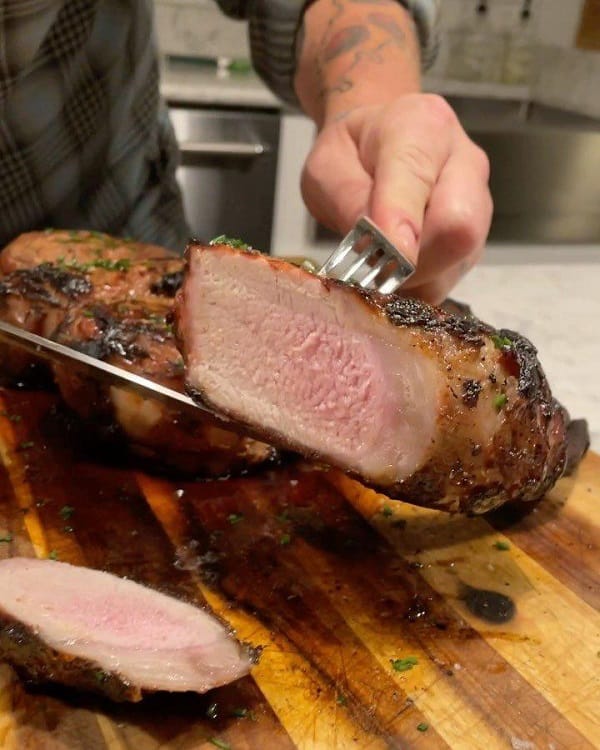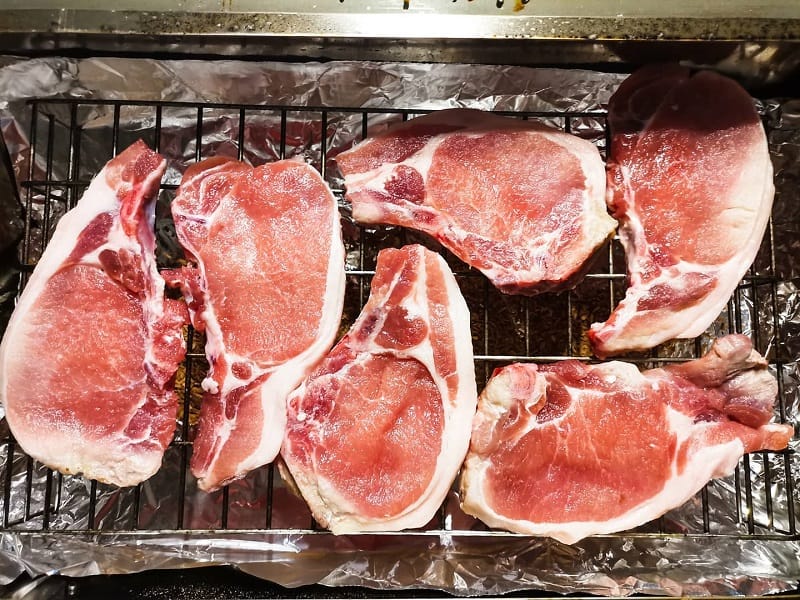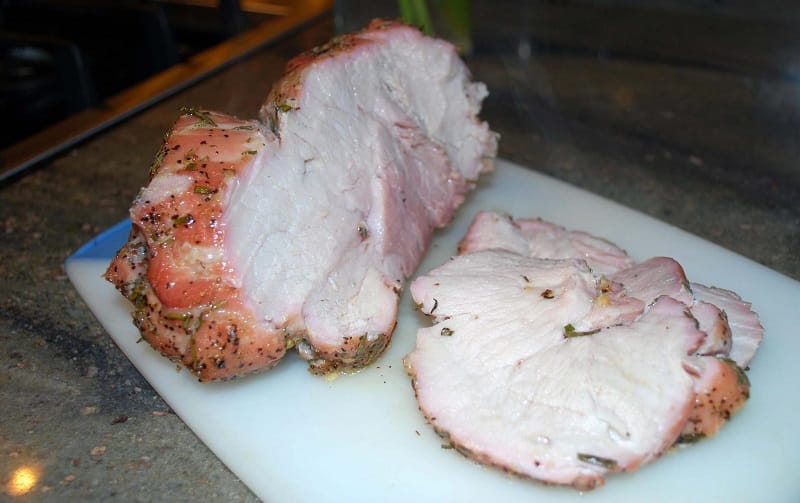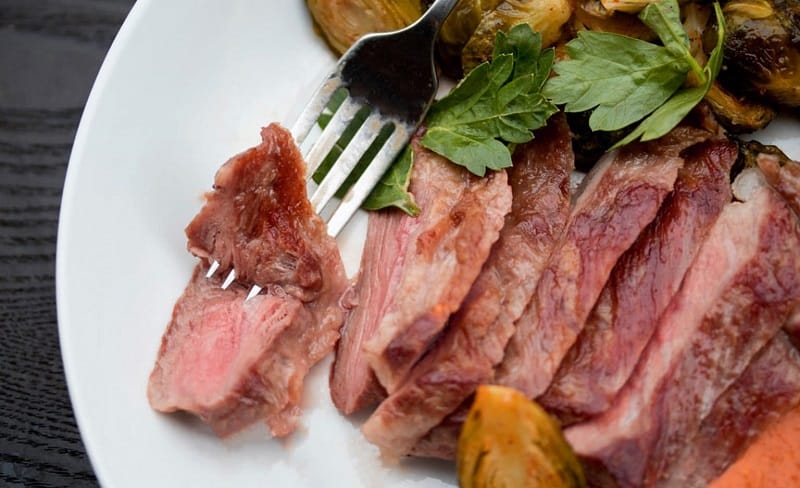Pork is a commonly consumed meat that’s used in various dishes worldwide. However, cooking pork to the right temperature is crucial to avoid health risks, such as salmonella and trichinosis. Undercooked pork can cause severe illnesses, and it’s essential to know what it looks like to prevent consuming it. So, what does undercooked pork look like? Understanding that you can’t always rely on pork color to indicate its doneness is crucial. Just because the meat is pink doesn’t mean it’s undercooked; the same goes for brown pork. This article will discuss the telltale signs of undercooked pork that you need to watch out for!
Can Pork Be Pink and Still Be Safe to Eat?

The short answer is yes, but there is more to it than that.
Regarding the safety of eating pork, the FDA has set maximum temperatures that pork must reach to be considered safe. This temperature is usually reached when the pork has an internal temperature of 145°F. This means that pork can still be considered safe even if it is slightly pink in the center.
However, while this is the general rule, other factors can come into play. For example, if the pork has been frozen and thawed, it must reach an internal temperature of 165°F before it is considered safe. This is because freezing and thawing can cause harmful bacteria to grow, and the higher temperature will kill any bacteria present.
It’s important to remember that even if pork is pink and still safe to eat, it should not be eaten in large quantities. The USDA recommends that no more than 3 ounces of cooked pork be consumed per person per day. This is because pork, like any other red meat, is high in saturated fats and cholesterol, which can harm your health if eaten in large quantities.
What Does Undercooked Pork Look Like?
When cooking pork, it’s important to ensure it’s fully cooked to avoid any potential health risks. Undercooked pork may appear pink or red, and the texture may be chewy. To ensure that pork is fully cooked, it’s recommended to use a meat thermometer to check the internal temperature. The minimum safe temperature for pork is 145°F, which should be cooked until it’s gray through.
Eating undercooked pork can result in foodborne illnesses such as food poisoning or Trichinella Spiralis, a worm parasite. It’s always better to be safe than sorry and thoroughly cook pork to avoid potential health risks.
What Does Undercooked Pork Tenderloin Look Like?

The easiest way to check the doneness of pork tenderloin is to use a meat thermometer. The internal temperature of the meat should reach 145°F before it is considered safe to eat. However, if you do not have a thermometer, there are some visual signs you can look for to determine if the pork is done.
Undercooked pork tenderloin will have a pink or slightly red hue to it. It will also be slightly soft to the touch since it has not been cooked long enough to become firm. The color should not be so pink that it looks raw but not completely white.
Another way to tell if pork tenderloin is undercooked is to sniff it. Raw meat, including pork, has a distinct smell that will become less noticeable as it cooks. It may not be done if the pork still has an overly strong smell.
Finally, the juices from undercooked pork tenderloin will be very thin and watery. As the pork cooks, the juices thicken and become more opaque. The pork may not be cooked through if the juices are still very thin and watery.
What Does Undercooked Pork Sausage Look Like?
The appearance of undercooked pork sausage can vary depending on the meat’s type, cut, and freshness. Generally, undercooked pork sausage will be light in color and will feel slightly spongy to the touch. Additionally, the sausage may have a slightly sour odor and a taste that has not yet been cooked through.
When preparing pork sausage, it is essential to follow cooking instructions closely. Sausage should be cooked to an internal temperature of 160°F to ensure it is safe to eat. To check the temperature of the sausage, you’ll need to use a thermometer.
To ensure that the sausage is cooked properly, you’ll need to cook it evenly. It should be cooked over medium heat, flipping the sausage often. If you’re grilling the sausage, it should be cooked over indirect heat, ensuring it cooks evenly.
In addition to properly cooking the sausage, you’ll need to use a food thermometer to ensure it is cooked through. The sausage should reach an internal temperature of 160°F when inserted into the center. If the thermometer reads a lower temperature, it may be necessary to continue to cook the sausage until it reaches the proper temperature.
Undercooked sausage can be dangerous, as there is a risk of bacteria and food-borne illnesses. To avoid potential health risks, it is important to ensure that pork sausage is properly cooked before eating.
Read more:
What Does Undercooked Pulled Pork Look Like?
What does undercooked pulled pork look like? If you’re unsure, it’s important to know what to look for to ensure your pulled pork is cooked to the correct temperature. Undercooked pulled pork can be dangerous to consume, so it’s important to get it right.
The texture is the first thing you should look for when determining if your pulled pork is undercooked. If it’s too soft and mushy, it’s likely undercooked. If it’s too tough and dry, it’s likely overcooked. You’ll also want to check the internal temperature of the pork with a meat thermometer. The safe internal temperature for cooked pork is 145 degrees Fahrenheit. If the internal temperature of your pulled pork is below this, it’s undercooked.
In addition to the texture and temperature, you should also look at the pulled pork’s color. Undercooked pulled pork will have a pinkish hue, whereas cooked pork will have a pale white or greyish color.
Finally, it would help if you also sniff the pulled pork. Undercooked pork will have a strong odor that is unpleasant to the nose. Once it’s cooked, the smell should be much more pleasant.
If your pulled pork has any of the above signs, it’s best to discard it and start again. Pulled pork that is undercooked can cause food poisoning, so it’s important to be extra careful when cooking it.
What Are The Risks Of Consuming Undercooked Pork?

Eating undercooked pork carries a risk of food poisoning, as it may contain bacteria or parasites that can make you sick.
The primary risk associated with eating undercooked pork is trichinosis. Trichinosis is an infection caused by the parasite Trichinella spiralis, which can be found in certain types of undercooked pork. The disease is rarely fatal but can cause serious symptoms such as fever, muscle pain, swollen eyes, and diarrhea. It can also cause serious complications, such as inflammation of the heart, lungs, and brain.
Other bacteria and parasites found in undercooked pork can also cause food poisoning. The most common are Salmonella, E. coli, and Staphylococcus aureus. These can cause nausea, vomiting, abdominal pain, and diarrhea. In some cases, they can cause serious complications, such as kidney failure and meningitis.
Another health risk associated with undercooked pork is an increased risk of colorectal cancer. Research has found that people who eat undercooked pork are more likely to develop colorectal cancer than those who do not consume pork.
Finally, eating undercooked pork is also associated with an increased risk of developing food allergies. Allergies to pork can range from mild reactions to severe anaphylactic reactions.
Can Undercooked Pork Make You Sick?
The short answer is yes, undercooked pork can make you sick. Eating undercooked pork can cause food poisoning, which can cause symptoms such as nausea, vomiting, stomach cramps, and diarrhea. These symptoms can last for several days and can be debilitating. Food poisoning can sometimes lead to severe complications such as dehydration, organ failure, and even death.
So, how can you ensure that pork is cooked properly? To ensure that pork is cooked adequately and is safe to eat, the internal temperature of the pork should be at least 145°F (63°C). A food thermometer should measure this temperature in the thickest part of the meat. Additionally, to be sure that the pork is cooked properly, the meat should be cooked until it’s no longer pink in the center.
What Are The Symptoms Of Food Poisoning From Undercooked Pork?
Food poisoning from undercooked pork is a severe and potentially life-threatening illness that can occur when pork is not cooked to the right temperature.
The most common symptom of food poisoning from undercooked pork is severe abdominal pain. This pain can be accompanied by diarrhea, vomiting, fever, and chills. Other signs and symptoms of food poisoning from undercooked pork can include nausea, loss of appetite, headache, dizziness, and fatigue. You should seek medical attention immediately if you experience these symptoms after eating undercooked pork.
In addition to the common symptoms of food poisoning from undercooked pork, you may also experience dehydration due to the diarrheal illnesses associated with food poisoning. Dehydration can cause symptoms such as extreme thirst, dry mouth, and dark urine.
In addition to the physical symptoms, food poisoning from undercooked pork can cause psychological distress. People who suffer from food poisoning may experience anxiety, depression, and fear of further contamination.
It’s important to be aware of the risks associated with undercooked pork and the signs and symptoms of food poisoning. If you think you have food poisoning, it’s important to seek medical attention right away. If you have recently consumed undercooked pork, practicing good hygiene and food safety practices is important to prevent further contamination.
How Do You Properly Cook Pork To Ensure It’s Fully Cooked?

Cooking pork to ensure it’s fully cooked is essential to food safety, as undercooked pork can contain harmful bacteria and parasites. With the right techniques and proper internal temperature, you can safely enjoy pork dishes that are both delicious and safe to eat.
First and foremost, it’s important to note that cooking times and temperatures vary depending on the cut of pork. Generally, larger cuts such as pork chops, pork roasts, or pork loins should be cooked to an internal temperature of 145°F with a three-minute rest before serving. Smaller cuts such as tenderloin, ground pork, and loin roast should be cooked to an internal temperature of 160°F.
It would help if you used a cooking thermometer to check the internal temperature regularly when cooking pork. It would help if you also were sure to use a shallow pan with a tight-fitting lid to minimize moisture loss and keep the pork from drying out.
The best way to ensure your pork is fully cooked is simple: keep an eye on the internal temperature. When the internal temperature is 145°F for larger cuts or 160°F for smaller cuts, the pork is done and ready to enjoy.
For an extra layer of safety, you can also marinate the pork before cooking. The marinade can help tenderize the pork and keep it moist while cooking. Just be sure to discard the marinade before cooking to avoid cross-contamination.
Finally, if you cook pork in the oven, use the right temperature and cooking times. Pork should be cooked at 350°F for about 20 minutes per pound, but this time may vary depending on the thickness of the pork.
How Do You Know When Pork Is Done?
The best way to check if your pork is cooked through is to use a food thermometer. This is the most accurate way to tell when your pork has reached a safe internal temperature. The USDA (US Department of Agriculture) recommends cooking pork until it reaches an internal temperature of 145°F (63°C).
You can also tell when pork is done cooking by looking at its color. Pork should be cooked until it’s light pink, and any juices that run from it should be clear. If your pork is still pink or gives off red or pink juices, it’s not yet done.
Another way to check if your pork is done is to examine the texture. Cooked pork should be tender and easy to cut. It must cook for a little longer if it’s still tough or difficult to cut.
Finally, if you’re cooking a pork roast, using a meat thermometer is best. Insert the thermometer into the thickest part of the roast and wait for the reading to come up. Your pork is done when the thermometer reads an internal temperature of 145°F (63°C).
What Can You Do If You Accidentally Eat Undercooked Pork?

If you have already eaten undercooked pork, one of the most important steps you can take is to practice good food safety and hygiene. It is important to wash your hands before and after handling any raw meat and always cook pork to an internal temperature of at least 145°F to kill any bacteria or parasites. It is also important to keep raw pork separate from other foods in the refrigerator and to never use the same cutting board or utensils for raw and cooked pork.
It is also important to recognize food poisoning signs and seek medical attention if necessary. Signs of food poisoning can include nausea, vomiting, abdominal pain, diarrhea, and fever. If you experience these symptoms after eating undercooked pork, it is important to seek medical attention immediately.
Eating undercooked pork can be a scary experience, but there are steps you can take to ensure your safety. It is essential to practice good food safety and hygiene and to always cook pork to an internal temperature of at least 145°F. It is also important to recognize food poisoning signs and seek medical attention if necessary. With a few simple precautions, you can help protect yourself from the risks of eating undercooked pork.
What Cooking Methods Are Best For Pork To Ensure It Is Fully Cooked?
Although a few cooking methods are suitable for pork, some are better than others in terms of ensuring the pork is cooked all the way through. Here are some of the best cooking methods for pork:
- Roasting: Roasting pork in the oven is one of the most effective ways of cooking pork to ensure it is fully cooked. To do this, preheat the oven to 350°F (177°C) and season the pork. Place the pork in a roasting pan and cook it for approximately 25 minutes per pound. Check the internal temperature of the pork before serving.
- Braising involves cooking pork in a small amount of liquid in a covered pan. This method allows the pork to absorb the liquid’s flavor while ensuring that it is fully cooked. Place pork in a large pan and add a liquid such as broth, wine, or beer to braise pork. Cover the pan and cook on low heat for approximately two to three hours.
- Grilling: Grilling is another great way to cook pork. Using medium-high heat, cook the pork for approximately 10 minutes per side. Make sure to move the pork around so that it cooks evenly. Check the internal temperature of the pork before serving.
- Slow Cooking: Slow cooking is an effective way to ensure pork is cooked all through. Add the pork and other ingredients to a slow cooker to slow-cook pork and set it to low heat. Cook the pork for at least 8 hours or overnight.
FAQs About What Does Undercooked Pork Look Like
Should Pork Be Rested Before Serving?

When cooking pork, it’s important to let it rest before serving. This is because the juices move toward the center when pork is cooked. The juices will evenly distribute throughout the meat by allowing the pork to rest for a few minutes. Resting the pork will also help the meat retain its moisture and prevent it from becoming dry and tough.
It’s recommended that pork rest for about five minutes before being served. This will give the meat enough time to absorb the juices and make it more flavorful. Overall, resting pork is an essential step in the cooking process, resulting in a delicious and juicy meal.
What Is The Ideal Temperature For Cooking Pork?
When it comes to cooking pork, the ideal temperature varies depending on the cut of meat.
For fresh-cut muscle meats like pork chops, roasts, loin, and tenderloin, the recommended temperature is 145° F. This temperature ensures maximum flavor without compromising safety.
- Ground pork should also reach a minimum internal temperature of 160°F for safety.
- The National Pork Board recommends cooking pork chops, roasts, and tenderloin to an internal temperature between 145° F (medium rare) and 160° F (medium).
- On the other hand, pork shoulder and ribs require a longer cooking time at a temperature of or below 275°F until the meat is tender. These cuts have a better texture and flavor when cooked between 180-195° F.
A little pinkness in pork is okay if it has reached the recommended internal temperature. By following these guidelines, one can enjoy tasty and safe pork dishes.
What Is The Best Way To Store Pork To Ensure It Stays Fresh And Safe To Eat?
It is important to take the necessary precautions to stay fresh and safe when storing pork. The best way to store raw pork is in the refrigerator at a temperature of 40°F or lower. Using the pork within three to five days of the “sell by” date on the package is important.
The pork should be used within three months of being frozen for the best quality. There are three safe ways to thaw pork: in the refrigerator, in cold water, or microwave. It is important to separate different kinds of raw animal-based foods and to place the absorbent paper under the meats for quick clean-up of unwanted drips.
Is Pink Pork The Same As Rare Pork?
To be factual, pink pork is not the same as rare pork. While rare beef is usually pink or red in the center, pork can be pink even if fully cooked. Some chefs argue that medium-rare pork is more succulent, tender, and flavorful than well-done pork.
While product and juice color are not reliable indicators of the safety of cooked pork, the temperature of 145 degrees Fahrenheit is a necessary guideline for safety. Therefore, as long as the pork is cooked to the appropriate temperature and not solely judged by its color, pink pork can be a delightful and safe option for food lovers.
Can The Color Of Pork Meat Indicate If It’s Undercooked?
It’s a common misconception that pork meat should be completely white when cooked. However, according to factual data, the color of pork meat cannot determine whether it’s undercooked. Even when cooked to a safe internal temperature of 145°F, pork can still appear pink or reddish. This discoloration is due to a chemical reaction as the meat is cooked.
Therefore, consumers should not rely on pork color to indicate doneness. Instead, they should use a meat thermometer to ensure it has reached the recommended temperature. By following these guidelines, consumers can safely enjoy their pork meat in a friendly tone of voice.
What Is Trichinosis, And How Is It Related To Undercooked Pork?
Trichinosis, or trichinellosis, is caused by eating undercooked or raw meat infected with Trichinella roundworms. While trichinosis was more common, it is now a relatively rare infection.
Undercooked or raw pork and pork products, such as pork sausage, are most commonly responsible for transmitting the disease to humans. Occasionally, people may become infected by eating the meat of wild bears, wild pigs, or other animals such as horses.
The symptoms of trichinosis typically occur within 2 to 7 days after consumption of infected meat and may include abdominal pain, diarrhea, nausea, and fever. To prevent contracting trichinosis, it is recommended that individuals cook meat to the appropriate temperature and avoid eating raw or undercooked meat, especially pork. Freezing meat at 5°F for at least 20 days can also effectively kill Trichinella roundworms.
How To Tell If Pork Is Done Without Thermometer?
If someone is cooking pork and doesn’t have a meat thermometer, they can still tell if it’s done by using a few simple tricks.
- The first is to feel the firmness of the meat using their thumb. If the pork shreds or comes away from the bone easily, it’s cooked well.
- Another way to test is by using the skewer method. As the pork cooks, it will get firmer, and once it stops getting firmer, it’s probably done.
- They can also touch their thumb to their middle finger to check if the meat is medium rare. Interestingly enough, cooked pork will have a similar firmness to the fleshy area below the thumb.
- Additionally, they can feel the webbing between their thumb and index finger to check if it feels like a rare piece of meat.
Using these methods, anyone can tell if their pork is done without a thermometer.
Conclusion
To conclude, the answer to the question “What does undercooked pork look like?” is generally pink and glossy on the outside while still red and raw on the inside. It is important to always cook pork to an internal temperature of 145 degrees Fahrenheit to avoid any health risks. While undercooked pork may look appetizing, it can cause serious health issues if not properly cooked. So take the time to ensure your pork is cooked to the proper temperature for the most delicious meal.
References:
- https://ask.usda.gov/s/article/Is-pink-pork-safe
- https://www.healthline.com/nutrition/raw-pork-or-undercooked-pork
- https://pork.org/pork-safety/

Hey readers! Chip Holland here, and I’m a Manager of this website. My passion for writing about it only matches my passion for BBQ. Follow my blog for mouth-watering recipes, tips, and tricks for the perfect smoke, grill, and BBQ. I’m sure you won’t be disappointed!
